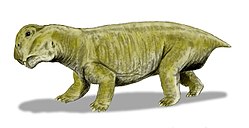| Euptychognathus Temporal range: Late Permian ~ | |
|---|---|
| Scientific classification | |
| Kingdom: | Animalia |
| Phylum: | Chordata |
| Clade: | Synapsida |
| Clade: | Therapsida |
| Clade: | † Anomodontia |
| Clade: | † Dicynodontia |
| Family: | † Lystrosauridae |
| Genus: | † Euptychognathus Kammerer et al. 2011 |
| Type species | |
| †E. bathyrhynchus (von Huene 1942) | |
| Other species | |
Euptychognathus is an extinct genus of dicynodont therapsid. [2] The type species E. bathyrhynchus was first named in 1942 as Dicynodon bathyrhynchus. Fossils of the genus have been recovered from the Usili Formation of the Ruhuhu Basin in Tanzania.







